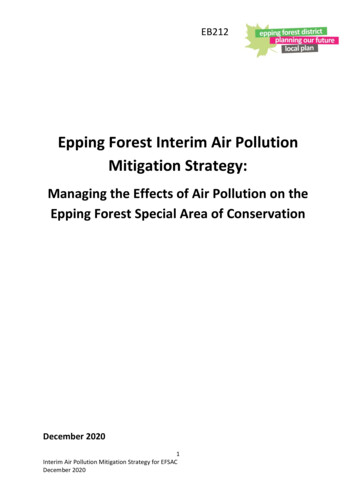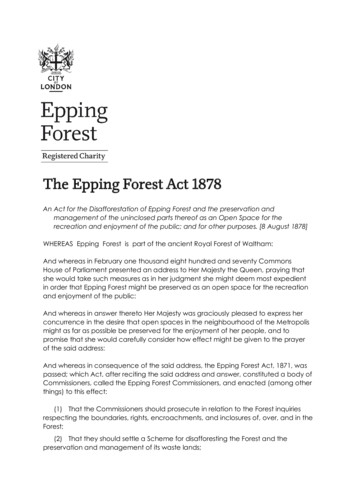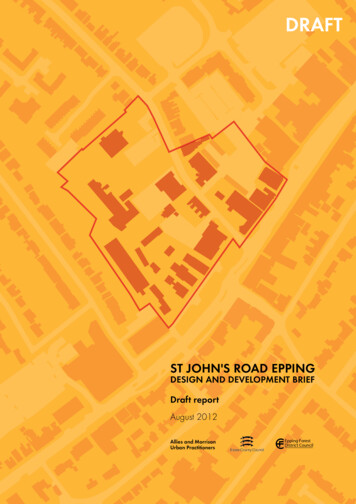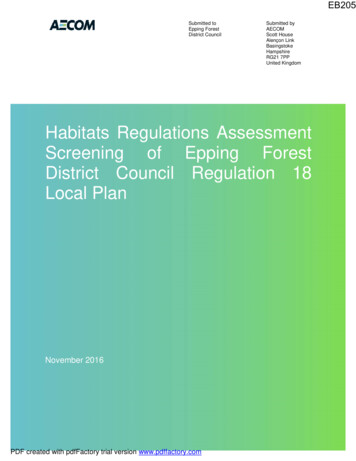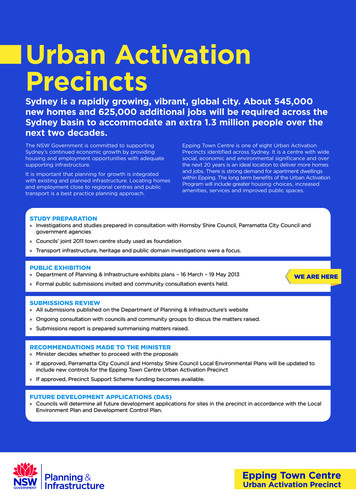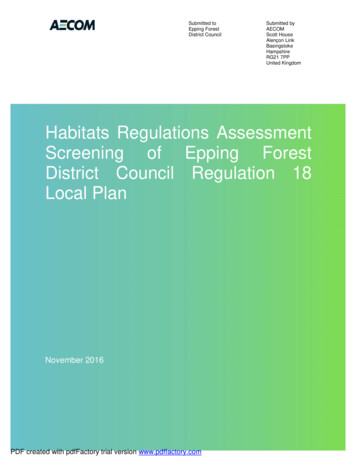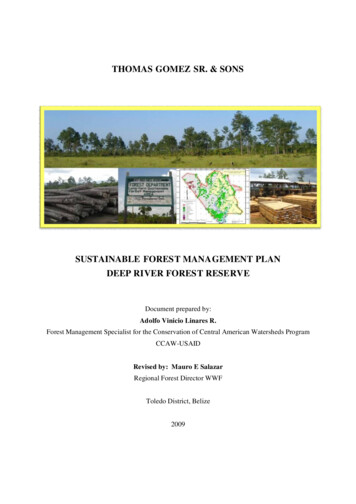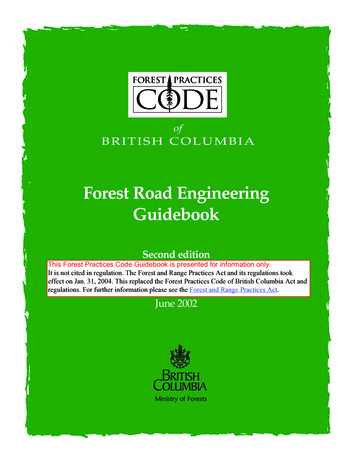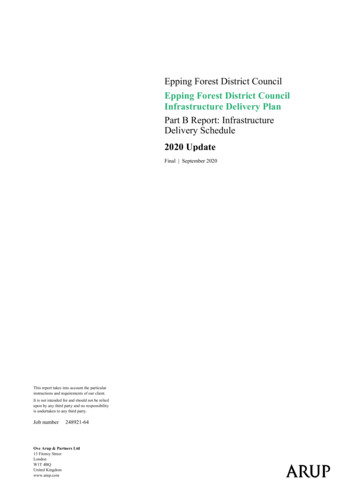
Transcription
Epping Forest District CouncilEpping Forest District CouncilInfrastructure Delivery PlanPart B Report: InfrastructureDelivery Schedule2020 UpdateFinal September 2020This report takes into account the particularinstructions and requirements of our client.It is not intended for and should not be reliedupon by any third party and no responsibilityis undertaken to any third party.Job number248921-64Ove Arup & Partners Ltd13 Fitzroy StreetLondonW1T 4BQUnited Kingdomwww.arup.com
Epping Forest District CouncilEpping Forest District Council Infrastructure Delivery PlanPart B Report: Infrastructure Delivery erviewEngagementIDP as a Live DocumentStructure1222Policy Context for Infrastructure 53.63.73.83.93.104National ContextRegional ContextLocal ContextHarlow and Gilston Garden TownLocations of GrowthInfrastructure Types and Scale of ReportingIdentifying infrastructure requirementsApproach to existing capacity surplus and deficitsRationalisation and e FundingApportioning costsInfrastructure Delivery 4.164.17999111313141416161618Infrastructure Delivery Schedule: District Wide19Infrastructure Delivery Schedule: Strategic Sites (Combined)23Infrastructure Delivery Schedule: East of Harlow28Infrastructure Delivery Schedule: Latton Priory33Infrastructure Delivery Schedule: Water Lane Area36Infrastructure Delivery Schedule: Buckhurst Hill39Infrastructure Delivery Schedule: Chigwell43Infrastructure Delivery Schedule: Epping46Infrastructure Delivery Schedule: Fyfield54Infrastructure Delivery Schedule: High Ongar55Infrastructure Delivery Schedule: Loughton56Infrastructure Delivery Schedule: Lower Nazeing64Infrastructure Delivery Schedule: Lower Sheering67Infrastructure Delivery Schedule: North Weald Bassett692020 Update Final September 2020
Epping Forest District Council4.184.194.204.214.224.234.244.25Epping Forest District Council Infrastructure Delivery PlanPart B Report: Infrastructure Delivery ScheduleInfrastructure Delivery Schedule: Ongar73Infrastructure Delivery Schedule: Roydon76Infrastructure Delivery Schedule: Sheering78Infrastructure Delivery Schedule: Stapleford Abbotts80Infrastructure Delivery Schedule: Theydon Bois82Infrastructure Delivery Schedule: Thornwood84Infrastructure Delivery Schedule: Waltham Abbey86Infrastructure Delivery Schedule: Suggestions from Town andParish Councils95AppendicesAppendix AInfrastructure Delivery Topic PaperAppendix BInfrastructure Delivery Topic Paper AddendumAppendix CInfrastructure Delivery Topic Paper Addendum: Highways ApportionmentAppendix DInfrastructure Delivery Topic Paper Addendum: Education ApportionmentAppendix EEngagementAppendix FMasterplan Areas Apportionment2020 Update Final September 2020
Epping Forest District Council1Introduction1.1OverviewEpping Forest District Council Infrastructure Delivery PlanPart B Report: Infrastructure Delivery ScheduleEpping Forest District Local Plan identifies site allocations to deliver new homesand new jobs over the Plan period (2011-2033). Development comes with a needfor supporting infrastructure including transport, education, health and communityfacilities to mitigate development impacts and support new communities.Epping Forest District Council (EFDC) commissioned the preparation of anInfrastructure Delivery Plan (IDP) to set out what the infrastructure requirementsto deliver the planned level of growth are. The IDP formed a key evidence basedocument for the Independent Examination of the Local Plan, and was formed oftwo parts: A review of the existing infrastructure was presented in the IDP Part Areport, produced in 2017. This baseline report was informed by consultationwith infrastructure and service providers, along with a review of relevantpolicy documents and modelling. It reported the existing infrastructure acrossEpping Forest District and identified any shortfalls in provision. From thisstarting point, the impact of growth over the Plan period was considered, andnew infrastructure requirements identified. The IDP Part B report, also produced in 2017, drew on the findings andoutputs on the IDP Part A report. The Part B report pulled together theinfrastructure requirements identified into an Infrastructure Delivery Schedule.The Schedule sets out the identified infrastructure required at different spatialscales for Epping Forest District for the period up 2016-2033.Since Part A and Part B were produced in 2017 and used to support theIndependent Examination of the Local Plan, this 2020 Update of the Part B reporthas been produced1. The purpose of the Update is to reflect changes made to theLocal Plan in the form of proposed Main Modifications, as well as additionalwork that has been undertaken since the IDP was first published.The Infrastructure Delivery Schedule included in this 2020 Update has a numberof purposes, including to: provide details and descriptions of the infrastructure required; present indicative costs associated with delivering the infrastructure requiredto support growth; summarise the potential funding sources that could be used to deliverinfrastructure upgrades, recognising that developer contributions will be a keypart of this;1Note, Part A of the IDP has not been subject to an update.2020 Update Final September 2020Page 1
Epping Forest District CouncilEpping Forest District Council Infrastructure Delivery PlanPart B Report: Infrastructure Delivery Schedule prioritise the infrastructure interventions according to whether considered‘critical’, ‘essential’ or ‘required’, and identify when in the Plan period theinfrastructure will be triggered; and Identify, where possible, the scale of the funding gap where funding is not fullycommitted. Set out the organisational responsibility for delivery and potential sources offunding.An Infrastructure Delivery Topic Paper was prepared in 2018 to support theLocal Pan Independent Examination and has built on the IDP. The purpose of theTopic Paper is to provide more information and certainty on infrastructuredelivery. This includes a high-level framework for apportionment arrangements tobe taken forward for key infrastructure identified in the IDP. More detailed andspecific pools will be further defined during the production of strategicmasterplans, concept frameworks and planning applications. The Topic Paper alsoprovides more information on those external funding sources outlined in the IDP,including the work currently ongoing to progress/secure funding, and any risks offunding not being in place and contingency measures for this. The Topic Paper isprovided in Appendix A, and the addendums on highways and education (updatedto reflect Main Modifications) are provided in Appendices B-D.1.2EngagementDevelopment of the IDP has involved engagement with a wide range ofstakeholders. Further information on the process for developing the InfrastructureDelivery Schedule with stakeholders is set out in Section 3.3.1.1.3IDP as a Live DocumentIDPs are, by their very nature, a ‘snapshot in time’, and as different infrastructureproviders respond to their own unique challenges, the information that theyprovide will naturally date and alter over time. It therefore needs to be recognisedfrom the outset that the IDP should be viewed as a ‘live document’.There are a number of areas of work ongoing which will further informinfrastructure requirements. The IDP will be reviewed periodically and updatedwhere necessary.1.4StructureThe remainder of the 2020 Update is set out below: Section 2 sets out the national, regional and local policy context for thedelivery of infrastructure and development of IDPs. Section 3 outlines the methodology used to develop the InfrastructureDelivery Schedule. Section 4 presents the Infrastructure Delivery Schedule, broken down bysettlement.2020 Update Final September 2020Page 2
Epping Forest District CouncilEpping Forest District Council Infrastructure Delivery PlanPart B Report: Infrastructure Delivery Schedule2Policy Context for Infrastructure Delivery2.1National Context2.1.1National Planning Policy Framework 2019The revised National Planning Policy Framework (NPPF) (2019) states that localplanning authorities must prepare a robust and evidence-based Local Plan whichseeks to deliver sustainable development. As part of the statutory requirement toproduce a Local Plan, national policy has placed a greater responsibility on localplanning authorities to plan for the delivery of various forms of infrastructure.Infrastructure Delivery Plans (IDPs) are therefore an important part of theevidence base for local development plans. Their purpose is to demonstrate thatthe infrastructure requirements necessary to support the level of housing andemployment growth proposed can be delivered. They also detail the level offunding required, highlight funding gaps, and identify potential funding sourcessuch as Section 106 (S106) agreements or CIL. An IDP is, therefore, a key part ofthe evidence base for local councils negotiating developer contributions throughS106 agreements or to help inform a CIL charging schedule.Paragraph 16 of the NPPF states that plans should be prepared positively, in a waythat is aspirational but deliverable, while being prepared with the objective ofcontributing to the achievement of sustainable development. Specifically, theNPPF states that both strategic (paragraph 20) and non-strategic (paragraph 28)policies should set out the overall strategy for the pattern, scale and quality ofdevelopment, and make sufficient provision for infrastructure, including transportand community facilities (such as health and education).Paragraph 34 of the NPPF states the following:Plans should set out the contributions expected from development. This should includesetting out the levels and types of affordable housing provision required, along with otherinfrastructure (such as that needed for education, health, transport, flood and watermanagement, green and digital infrastructure). Such policies should not undermine thedeliverability of the plan.2.1.2Planning Practice GuidanceThe Planning Practice Guidance (PPG) (paragraph 059, reference 61-05920190315) explains the role and function of a Local Plan in deliveringinfrastructure, stating: The Local Plan should identify what infrastructure is required and how it canbe funded and brought forward. Early discussion with infrastructure and service providers should beundertaken to collaboratively identify infrastructure deficits and requirements,and opportunities for addressing them. In doing so they will:2020 Update Final September 2020Page 3
Epping Forest District CouncilEpping Forest District Council Infrastructure Delivery PlanPart B Report: Infrastructure Delivery Schedule Assess the quality and capacity of infrastructure, and its ability to meetforecast demands. Policies should set out how identified deficiencies willbe addressed. Take account for strategic infrastructure, including nationally andsignificant infrastructure, within these areas. An Infrastructure Funding Statement (IFS) should be prepared using availableevidence to set out the anticipated funding from developer contributions, andthe choices local authorities have made about how these contributions will beused. Where longer term growth is planned through new settlements or significantextensions to existing villages or town, less detail may be provided as theposition regarding the provision of infrastructure is likely to be less certain. Inthese circumstances, it is expected that authorities will demonstrate areasonable prospect that the proposals can be developed within the timescaleenvisaged.2.1.3Infrastructure Funding StatementsWhilst the preparation of Infrastructure Funding Statements (IFS) is only arecommendation within the PPG, this is now a legal requirement for all localauthorities following the latest amendment to the Community Infrastructure Levy(CIL) Regulations (2010), which came into force in September 2019.The regulations state that IFSs should include details of how much money hasbeen raised through developer contributions, both from CIL and Section 106planning obligations, and how it has been spent. A full list of the matters to beincluded in IFSs is stated in Schedule 2 of the CIL Regulations.IFSs must be published on local planning authority websites at least once a yearand councils will be required to publish their first statements by 31 December2020.2.1.4Planning ObligationsPlanning obligations assist in mitigating the impact of unacceptable developmentto make it acceptable in planning terms. Planning obligations may only constitutea reason for granting planning permission if they meet all the following tests setout in Paragraph 56 of the NPPF: necessary to make the development acceptablein planning terms; directly related to the development; and fairly and reasonablyrelated in scale and kind to the development. The PPG (paragraph 002, reference10-002-20190509) states that local authorities should ensure that the combinedtotal impact of such requests, and policies more generally, does not threaten thedeliverability of the plan.Developers may be asked to provide contributions for infrastructure in severalways. This may be by way of Community Infrastructure Levy (CIL) charged, orthrough Section 106 Agreements and Section 278 Agreements relating tohighways works.2020 Update Final September 2020Page 4
Epping Forest District CouncilEpping Forest District Council Infrastructure Delivery PlanPart B Report: Infrastructure Delivery ScheduleEFDC does not yet have a CIL charging schedule, but may decide to bring oneforward in the future. EFDC utilises Section 106 agreements to secure funding tomitigate impacts from developments. In the emerging Local Plan, the approach toplanning obligations is set out in relation to infrastructure delivery. The Councilwill consider introducing a Community Infrastructure Levy (CIL) and willimplement this for areas and/or development types where a viable chargingschedule would best mitigate the impacts of growth. If implemented, section 106will continue to be the appropriate mechanism for securing land and works alongwith financial contributions where a sum for the necessary infrastructure is notsecured via CIL, including for Affordable Housing.The government’s White Paper ‘Planning for the Future’, published in August2020, includes proposals to abolish the current system of planning obligations andto replace CIL with an ‘Infrastructure Levy’ to be charged as a fixed proportion ofthe development value above a threshold, with a mandatory nationally-set rate orrates. At the time of writing, this remains a proposal only.2.2Regional ContextThe NPPF sets out the duty for local authorities to co-operate, recognising thecrucial need for co-ordinated growth and infrastructure delivery. This means that arange of organisations at a sub-regional level have a role in infrastructure planningand delivery.2.2.1Greater Essex Growth and Infrastructure Framework2016 – 2036The Greater Essex Growth and Infrastructure Framework (GIF) wascommissioned by all local and unitary authorities in Essex. Covering a 20-yearperiod from 2016 – 2036, the GIF presents an overview of housing andemployment growth patterns across the county and identifies future infrastructurerequirements and funding gaps.The estimated cost of delivering the level of infrastructure needed to support thecounty’s growth was found to be approximately 10.4 billion. A comparison tothe level of secured funding from public, private and developer contributionsidentified a funding gap of 4.4 billion. This was exacerbated by growth over theprevious decade not being matched by a corresponding growth in infrastructurefunding, leading to a deficit in infrastructure provision. It was identified thatmajor transport projects in the region need to secure 36.5bn, and 5.5bn for crossboundary projects. These projects have a funding gap of 11bn.2020 Update Final September 2020Page 5
Epping Forest District CouncilEpping Forest District Council Infrastructure Delivery PlanPart B Report: Infrastructure Delivery ScheduleFigure 1 Major housing and employment growth locations within the GIF study area2.2.2Essex County Council Developers’ Guide toInfrastructure ContributionsThe Developer’s Guide to Infrastructure Contributions sets out the CountyCouncil’s approach to securing appropriate infrastructure provision to supportdevelopment. The Guide details the scope and range of contributions towardsinfrastructure, which Essex County Council may seek from developers andlandowners in order to make development acceptable in planning terms.The Guide sets out infrastructure policy standards and costing information, to helpstandardise the approach to delivery, and ensure new developments aresustainable. This document has been used as a starting point for identifying thequantum and provision of infrastructure required to support growth over the Planperiod.2.2.3Essex Design GuideThe Essex Planning Officer Association (EPOA) and Essex County Council coproduced the 2018 iteration of the Essex Design Guide to provide county-levelguidance on best practise design and place making for developments within thecounty. It is the first fully online and interactive design guide in the UK.Detailed design guidance is provided covering architecture, urban design andlandscape architecture, in addition to infrastructure-related considerations such asstreets and roads, flooding and green infrastructure. Supplementary guidance isalso provided, covering topics such as Health Impact Assessments, school design,or engagement with the emergency services.2020 Update Final September 2020Page 6
Epping Forest District CouncilEpping Forest District Council Infrastructure Delivery PlanPart B Report: Infrastructure Delivery ScheduleThe guide also identifies five socio-economic themes that good design should aimto address in the county: Active Design Principles Ageing Population Health and Wellbeing Digital and Smart Technology Garden Communities2.3Local ContextThe Epping Forest District Local Plan Submission Version 2011-2033 (EFDCLPSV) was submitted to the Secretary of State for examination in public on 21September 2018. The Plan sets out the approach, strategy and detailed policies formeeting the District’s needs from 2011 up to 2033.The Local Plan sets out the vision and objectives for the District’s development,including sustainable homes high quality and natural environment, a strongeconomy and new employment land space, vibrant town centres and sustainabletransport options. It also includes proposal for delivery and the mechanisms bywhich the Council will ensure that infrastructure required to underpin the Planwill be delivered. The Plan makes direct reference to the IDP and its ability todemonstrate the infrastructure requirements necessary to support the siteallocations.The Local Plan is subject to an Independent Examination. Hearing sessions wereheld in February to June 2019, and the Council has responded to actions set out bythe Inspector in her initial advice (ED98). A series of Main Modifications,required to make Plan sound and legally-compliant, have been proposed to theInspector and these will be subject to formal consultation upon agreement by theInspector.Policies D1 to D7 set out the policy for the delivery of infrastructure. Policy D1A. specifically states that:New development must be served and supported by appropriate on andoff-site infrastructure and services as identified through theInfrastructure Delivery Plan.Policies D2 to D5 outline that development proposals will be permitted onlywhere they provide or improve the infrastructure required to serve the scale of theproposed development. Policies relevant to the delivery of infrastructure include: Essential facilities and services (Policy D2) Utilities (Policy D3) Community, leisure and cultural facilities (Policy D4) Communications infrastructure (Policy D5)2020 Update Final September 2020Page 7
Epping Forest District CouncilEpping Forest District Council Infrastructure Delivery PlanPart B Report: Infrastructure Delivery SchedulePolicy D6 details the council’s support for the preparation and production ofNeighbourhood Plans which contribute towards the strategic objectives of theLocal Plan, which include infrastructure delivery. Finally, Policy D7 monitoringand enforcement states that the Council will monitor the implementation of theLocal Plan policies and infrastructure provision and commits to reporting theresults on an annual basis.2.4Harlow and Gilston Garden TownAlong with EFDC, Harlow District Council, East Herts District Council,Hertfordshire County Council and Essex Country Council are working together tobring forward the transformational growth of Harlow as the Harlow and GilstonGarden Town. The objectives of the Garden Town are to deliver sustainablegrowth and infrastructure of considerable scale and significance, which will meethousing and employment needs, deliver regeneration objectives and create a highquality environment.Approximately 16,000 new homes are planned for the Garden Town within theCouncils’ plan periods to 2033 (including units already delivered or consented),with an additional 7,000 delivered beyond the plan periods. The Garden Towncomprises development sites both within the Harlow administrative area andwithin East Hertfordshire District and Epping Forest District, including: 750 homes at East of Harlow (with an additional 2,600 within Harlow’sadministrative area); 2,100 at Water Lane Area; and 1,050 units at Latton Priory.Other sites include 10,000 homes at Gilston in East Herts District, and sites withinHarlow District Council.The delivery of the Garden Communities will need to be underpinned by acomprehensive package of infrastructure, which will need to be phased anddelivered in a timely way ahead of or in tandem with the development it serves.This necessitates a coordinated approach across local authority boundaries and theinvolvement of a range of partners, including the site owners/promoters,infrastructure providers and other stakeholders. The Councils have workedtogether to produce a Harlow and Gilston Garden Town IDP, published in 2019,as well as a Spatial Vision and Design Charter framework which will provide anoverarching spatial vision across the Garden Communities, and emerging work onplanning obligations (which may take the form of a development plan documentor supplementary planning document).2020 Update Final September 2020Page 8
Epping Forest District CouncilEpping Forest District Council Infrastructure Delivery PlanPart B Report: Infrastructure Delivery Schedule3Methodology3.1Locations of GrowthThe IDP reflects and plans for the level and locations of growth set out in theLocal Plan and its proposed Main Modifications. This growth is set out in Figure2.Figure 2 Locations of growthSettlementTotalHarlow sites3,900Water Lane Area2,100Latton Priory1,050East of HarlowNorth Weald Bassett7501,050Waltham Abbey836Epping716Chipping ower Nazeing93Buckhurst Hill87Sheering84Theydon Bois57Roydon48Stapleford Abbotts33Fyfield14Lower Sheering14High Ongar10Rural site allocations and traveller site allocations have been matched to thesettlement to which they have the strongest functional link.The IDP also reflects commitments (planning permissions which have beengranted but not yet delivered) and recent completions.3.2Infrastructure Types and Scale of ReportingThe Schedule covers the physical and social infrastructure types shown in Figure3, and reported at the spatial scales identified in Figure 4. Some infrastructuretypes discussed in the baseline are not reported in the Schedule where no2020 Update Final September 2020Page 9
Epping Forest District CouncilEpping Forest District Council Infrastructure Delivery PlanPart B Report: Infrastructure Delivery Schedulethe Schedule where no identified project or intervention has been identified asnecessary to assist in the delivery of growth.Figure 3 Infrastructure types identified in the lBusesWalking and CyclingEducationEarly Years and ChildcarePrimary SchoolsSecondary SchoolsHealth and Social CareGPsDentistsAdult social careCommunity and SportCommunity CentresIndoor Sports FacilitiesOutdoor Sports FacilitiesOpen Space and GreenInfrastructureNatural and semi-natural open spaceInformal recreationManaged open spaceAllotmentsChildren’s playGreen asBroadbandInfrastructure provision has been considered across a range of spatial scales, tofully reflect what is required to serve growth areas.2020 Update Final September 2020Page 10
Epping Forest District CouncilEpping Forest District Council Infrastructure Delivery PlanPart B Report: Infrastructure Delivery ScheduleFigure 4 Spatial scales reported in the ScheduleSpatial ScaleInfrastructure schemesDistrictInfrastructure required to serve growth across theDistrict as a wholeStrategic sites combinedInfrastructure required to serve growth across thestrategic sites at the Harlow and Gilston Garden Townas a wholeStrategic sitesInfrastructure required to specifically support growth ineither the Water Lane Area, East of Harlow or LattonPriory strategic sites.SettlementsInfrastructure interventions required to support growthwithin specific settlements across the District.It should also be noted that different infrastructure types were assessed andcalculated across a range of geographies. This was informed by consultation withproviders, and was used to best reflect how services are delivered and used. Theseare referenced below, and set out in more detail in Part A of the IDP: Primary Schools – assessed in Primary Forecast Planning Groups Secondary Schools – assessed in Secondary Forecast Planning Groups GP surgeries – assessed in Neighbourhood Areas3.3Identifying infrastructure requirementsFuture infrastructure requirements associated with growth identified in the Planperiod have been assessed through a combination of stakeholder consultation, areview of existing evidence-base strategies and forecast modelling. The futureinfrastructure requirements have been updated as part of this 2020 Update toreflect updated site capacities and trajectory, as well as more recent work onparticular infrastructure types.3.3.1Consultation with providersExtensive stakeholder consultation was undertaken as part of the 2017 version ofthe IDP to establish the likely additional infrastructure requirements arising fromgrowth over the Plan period (See Appendix E). This included officers fromEFDC, Harlow, East Hertfordshire and Essex County Council. In addition,consultation was undertaken with representatives from Transport for London,Network Rail, utility companies for water, wastewater, gas and electricity, theWest Essex Clinical Commissioning Group, NHS England and representativesfrom the emergency services. The growth forecasts were shared withinfrastructure providers and stakeholders, who commented on the likely impact ofgrowth on existing provision in the District. The ability of existing infrastructureto absorb this additional demand, and the need for new facilities, were alsoconsidered as part of this process.2020 Update Final September 2020Page 11
Epping Forest District CouncilEpping Forest District Council Infrastructure Delivery PlanPart B Report: Infrastructure Delivery ScheduleStakeholder consultation formed part of an iterative process, with additionaldiscussions with providers in line with changes to site allocations and phasing.Although standards set out in the ECC Developers’ Guide to InfrastructureContributions provided a useful starting point in identifying infrastructure need,where more up to date information was received from infrastructure providers,this information was superseded. This was to ensure that schemes in the Schedulebetter reflect how infrastructure is assessed, delivered and funded. In someinstances, changing models of service delivery also affected the spacerequirements associated with future infrastructure provision. Examples of thisinclude the trend towards ‘hub’ models and co-location, whereby several servicessuch as community centres and libraries may operate out of the same facility. Itshould therefore be noted that for some types of infrastructure, a more flexibleapproach to provision and delivery may be appropriate. It will be necessary thatthe IDP is updated regularly as policy changes come into effect, to reflect thesechanges in delivery.As part of the 2020 Update, follow-up engagement with EFDC and Essex CountyCouncil has been undertaken to understand changing infrastructure requirements.3.3.2Forecast modellingForecast modelling was undertaken to demonstrate requirements in line withpolicy standards. These standards of provision have been used to modelinfrastructure requirement across the Plan period, and calculate need in line withthe housing trajectory for growth.For certain infrastructure sectors, it was possible to set infrastructure benchmark‘standards’, which can be used to derive estimates of the amount of provision thatis required. Where standards for infrastructure were found, future demand forthose services has been modelled. The methodology associated with the forecastmodelling is set out in full in Part A of the IDP.Demand forecasting was undertaken for the following infrastructure as part of this2020 Update: Early years provision Community floorspace Adult social care GP surgeries (to update the figures originally provided by West Essex CCGreflected in the 2017 version of the IDP) Dentists Open Space (to update the figures originally reported in the Open SpaceStrateg
Epping Forest District Council Epping Forest District Council Infrastructure Delivery Plan Part B Report: Infrastructure Delivery Schedule 2020 Update Final September 2020 Page 1 1 Introduction 1.1 Overview Epping Forest District Local Plan identifies site allocations to deliver new homes and new jobs over the Plan period (2011-2033).
